The History of Romania
Part 2: The Medieval - Wallachia, Moldavia, Transylvania
Beginning with the 10th century, the Byzantine, Slav and Hungarian sources, and later on the western sources mention the existence of statehood entities of the Romanian population - kniezates and voivodates - first in Transylvania and Dobrudja, then in the 12-13th centuries, also in the lands east and south of the Carpathians. A specific trait of the Romanian's history from the Middle Ages until the modern times is that they lived in three Principalities that were neighbours, but autonomous - Wallachia, Moldavia and Transylvania.
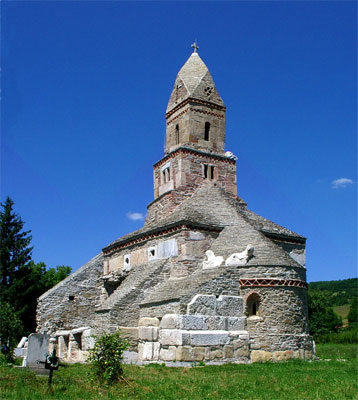
|
This phenomenon - which is by no means unique in Mediaeval Europe - is extremely complex. The underlying causes pertain to the essence of the feudal society, but there are also specific factors. Among the latter, we wish to mention the existence of powerful neighbouring empires, which opposed the unification of the Romanian state entities and even occupied - for shorter or longer periods of time - Romanian territories. For instance, to the west the Romanians had to face the policy of conquests conducted by the Hungarian kingdom. In 895, the Hungarian tribes, who came from the Volga lands, led by Arpad, settled in Pannonia. They were stopped in their progress towards the west by emperor Otto I (995) so the Hungarians settled down and turned their eyes to the south-east and east. There they encountered the Romanians.
A Hungarian chronicle describes the meeting between the messengers sent by Arpad, the Hungarian king, and voivode Menumorut of the Biharea city in western Transylvania. The Hungarian ambassadors demanded that the territory be handed over to them. The chronicle has preserved for us the dignified answer given by Menumorut: 'Tell Arpad, the Duke of Hungary, your ruler. Verily we owe him, as a friend to a friend, to give him all that is necessary because he is a foreigner and a stranger and lacks many. But the land that he has demanded from our good will we shall never give to him, as long as we are alive'.
Despite the resistance of the Romanian kniezates and voivodates, the Hungarians succeeded in the 10-13th centuries to occupy Transylvania and make it part of the Hungarian kingdom (until the beginning of the 16th century as an autonomous voivodate.) In order to consolidate their power in Transylvania, where the Romanians continued to be, over the centuries, the great majority ethnic element, as well as to defend the southern and eastern borders of the voivodate, the Hungarian crown resorted to the colonisation of Szecklers and Germans (Saxons) in the 12-13th centuries in the frontier areas.
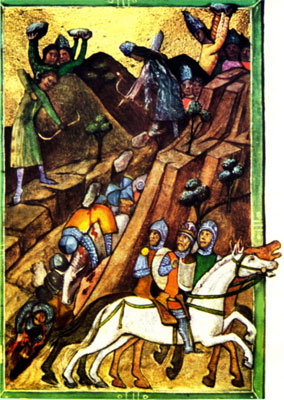
|
victory of the Romanians at Posada (1330) against the army of the Hungarian King |
In the 14th century, with the decline of the neighbouring imperial powers (the Poles, the Hungarians, the Tartars), south and east of the Carpathian Mountains range the autonomous feudal states were formed: Wallachia, under Basarab I (around 1310) and Moldavia, under Bogdan I (around 1359). The Polish and Hungarian kingdoms attempted in the 14-15th centuries to annex or subordinate the two principalities, but they did not succeed.
In the second half of the 14th century a new threat against the Romanian lands emerged: the Ottoman Empire. After first setting foot on European soil in 1354, the Ottoman Turks began their rapid expansion on the continent, so the green banner of the Islam already flew south of the Danube in 1396.
Alone or in alliance with the neighbouring Christian countries, more often in alliance with the neighbouring voivodes of the other two Romanian principalities, the voivodes of Wallachia Mircea the Old (1386-1418) and Vlad the Impeller (Dracula of the Mediaeval legends, 1456-1462), with Stephen the Great and Holy (1457-1504), the voivode of Moldavia and Iancu of Hunedoara, the voivode of Transylvania (1441-1456) fought heavy defence battles against the Ottoman Turks, delaying their expansion to Central Europe.
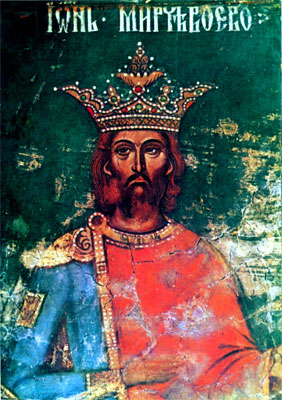
|
Voivode of Wallachia (1386-1418) |
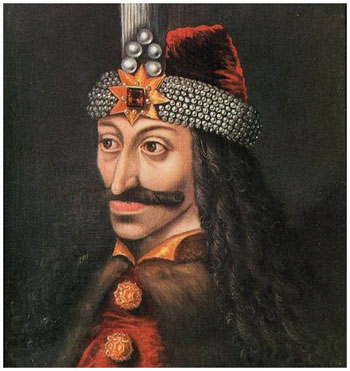
|
(Dracula of the Medieval legends, 1456-1462) |
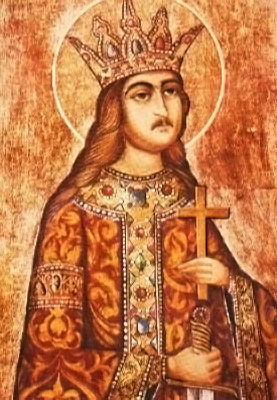
|
Voivode of Moldavia (1457-1504) |
The whole Balkan Peninsula became a Turkish-ruled territory, Constantinople was captured by Mohammed II (1453), Suleiman the Magnificent captured the city of Belgrade (1521), and the Hungarian kingdom disappeared following the battle of Mohacs (1526). Therefore, Wallachia and Moldavia were surrounded and they had to recognise for over three centuries the suzerainty of the Ottoman Empire. After Buda was captured and Hungary became a pashalik, Transylvania became a selfruling principality (1541) and it, too, recognised the suzerainty of the Ottoman Empire, as the other two Romanian lands. Unlike all the other peoples of south-east Europe, unlike the Hungarians and the Poles, the Romanians were the only ones who maintained their state entity during the Middle Ages, along with their own political, military and administrative structures. The tribute paid to the sultan was the guarantee for the preservation of domestic autonomy, but also for the protection against more powerful enemies. Wallachia and Moldavia, owing to their autonomy status, continued after the fall of the Byzantine Empire to foster their Byzantine cultural traditions, taking at the same time upon themselves to protect the Eastern Orthodox religion; on their territory, scholars from all over the Balkan Peninsula, chased away by the intolerant Islam, were able to continue their work without any obstacles; they prepared the cultural revival of their nations.
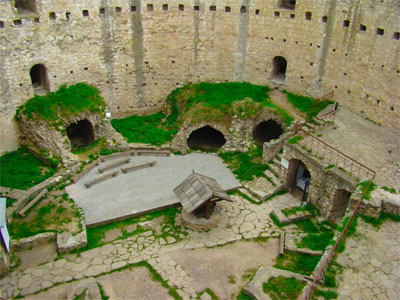
|
The end of the 16th century was dominated by the personality of Michael the Brave. He became voivode of Wallachia in 1593, joined the Christian League - an anti-Ottoman coalition initiated by the Papacy and the Holy Roman Empire and he succeeded, following heavy battles (Calugareni, Giurgiu) to actually regain the independence of his country. In 1599-1600 he united for the first time in history all the territories inhabited by Romanians, proclaiming himself 'prince of Wallachia, Transylvania and the whole of Moldavia.' The domestic situation was very complex, the neighbouring great-powers - the Ottoman Empire, Poland, the Hapsburg Empire - were hostile and joined forces to overthrow him; so this union was short-lived as Michael the Brave was assassinated in 1601. The union achieved by the valiant voivode became, however, a symbol to the posterity. In the 17th century, in various forms and with evanescent success, other princes attempted to restart the ambitious political program of Michael the Brave, by trying to form a united anti-Ottoman front, made-up of the three principalities and to restore the unity of ancient Dacia.
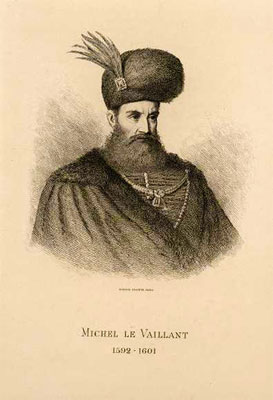
|
The end of the 17th century and the beginning of the 18th century brought about changes in the politics of Central and Eastern Europe. The Ottoman Empire failed to capture Vienna in 1683 and following that, the Hapsburg Empire began its expansion to the south-east of Europe. The Austrian-Turkish peace treaty of Karlowitz (1699) sanctioned the annexation of Transylvania and its organisation as an autonomous principality to Hapsburg Austria (since 1765 great principality), ruled by a governor. Poland was divided and Russia, by successive conquests, reached under Peter the Great (1696-1725) the Dniester river, thus becoming Moldavia's eastern neighbour. The ambitious dream of the czars to dominate the Bosporus strait and Constantinople placed the Romanian Principalities in the way of Russian expansionism. The Ottoman Empire, in an attempt to defend its old position, introduced in Moldavia (1711) and Wallachia (1716) the 'Phanariot regime,' (until 1821), under which the Sublime Porte appointed in the two principalities Greek voivodes recruited from the Phanar district of Istanbul and considered faithful to the Turks. That was a time when the Ottoman political control and economic exploitation increased and corruption spread; but some social reforms were also introduced - such as the abolition of serfdom - as well as administrative and modernising reforms, modelled on the European ones in the age of the Enlightenment. The domestic autonomy, although limited, was basically preserved and the two principalities continued to be distinct entities from the Ottoman Empire; this situation was recognised in several international treaties (for instance that of Kuchuk-Kainargi, 1774). Lying at the borders of three great empires and wanted by all three of them, Wallachia and Moldavia became for over 150 years not only territories of contention but also a battlefield on which the armies of the empires fought each other.
Many wars were fought by Austria and Russia against the Ottoman Empire (1710-1711, 1716-1718, 1735-1739, 1768-1774, 1787-1792, 1806-1812, 1828-1829, 1853-1856): those battles took place on Romanian soil, always accompanied by a foreign military occupation, which was often maintained long after the war proper was over, so the Romanian lands endured not only through devastation and irrecoverable losses but also through population displacements and painful territory amputations. So, Austria temporarily annexed Oltenia (1718-1793) and Northern Moldavia that they called Bukovina (1775-1918). Following the Russian-Turkish war of 1806-1812, Russia annexed the eastern part of Moldavia, the land between the Prut and Dniester rivers, later called Bessarabia (1812-1918).
